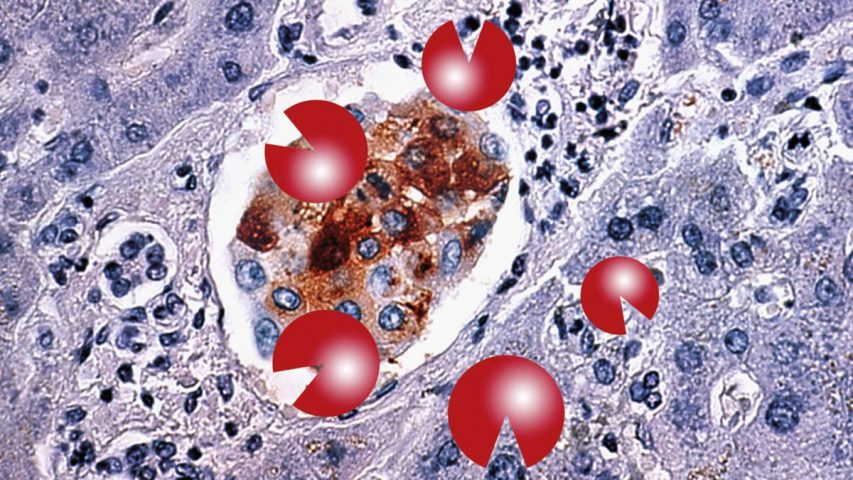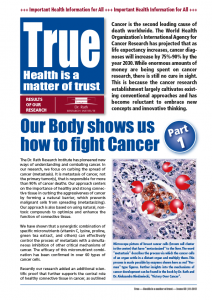- Have any questions? Contact us!
- info@dr-rath-foundation.org

Scientific Focus on Anti-Cancer-Effects of Vitamin C
October 4, 2017
Our Body Shows Us How to Fight Cancer – Part 2
October 4, 2017Our Body Shows Us How to Fight Cancer – Part 1

 Cancer is the second leading cause of death worldwide. The World Health Organization’s International Agency for Cancer Research has projected that as life expectancy increases, cancer diagnoses will increase by 75%-90% by the year 2030. While enormous amounts of money are being spent on cancer research, there is still no cure in sight. This is because the cancer research establishment largely cultivates existing conventional approaches and has become reluctant to embrace new concepts and innovative thinking.
Cancer is the second leading cause of death worldwide. The World Health Organization’s International Agency for Cancer Research has projected that as life expectancy increases, cancer diagnoses will increase by 75%-90% by the year 2030. While enormous amounts of money are being spent on cancer research, there is still no cure in sight. This is because the cancer research establishment largely cultivates existing conventional approaches and has become reluctant to embrace new concepts and innovative thinking.
The Dr. Rath Research Institute has pioneered new ways of understanding and combating cancer. In our research, we focus on curbing the spread of cancer (metastasis). It is metastasis of cancer, not the primary tumor(s), that is responsible for more than 90% of cancer deaths. Our approach centers on the importance of healthy and strong connective tissue in curbing the aggressiveness of cancer by forming a natural barrier, which prevents malignant cells from spreading (metastasizing). Our approach is also based on using natural, nontoxic compounds to optimize and enhance the function of connective tissue.
We have shown that a synergistic combination of specific micronutrients (vitamin C, lysine, proline, green tea extract, and others) can effectively control the process of metastasis with a simultaneous inhibition of other critical mechanisms of cancer. The efficacy of this micronutrient combination has been confirmed in over 60 types of cancer cells.
Recently our research added an additional scientific proof that further supports the central role of healthy connective tissue in cancer, as outlined by Dr. Rath more than 20 years ago. In an innovative concept Dr. Rath postulated that, in the event of a chronic deficiency of vitamin C, our body produces a unique large molecule – lipoprotein (a) – which can reinforce weak connective tissue. Therefore, lipoprotein(a) or Lp(a) acts as a temporary surrogate for vitamin C. However, the same Lp(a) that acts as a “repair” molecule in atherosclerotic plaques can also help in curbing the spread of cancer by reinforcing weak connective tissue.
Our recent research study has been conducted using a unique mouse model (Gulo-/-; Lp(a)+) that we developed at our Institute. This mouse model mimics human metabolism in its two critical aspects: lack of internal synthesis of vitamin C and an ability to produce Lp(a). This specific mouse model imitates a unique event in human metabolism that occurred some 40 million years ago. That was the time when humans lost the ability to make their own vitamin C and when the Lp(a) gene emerged in our ancestors. In an earlier study, we used this mouse model to establish definitive proof that Lp(a) acts as a temporary repair molecule in blood vessel walls that have been weakened by a dietary deficiency of vitamin C, therefore leading to atherosclerosis.¹
In our most recent study², we used the (Gulo-/-; Lp(a)+) mouse to enhance our understanding of natural mechanisms associated with cancer growth and development. In particular, we wanted to know whether Lp(a) plays a similar role (that of a surrogate for vitamin C) in cancer as it does in atherosclerotic heart disease. We will present the results of this study in more detail in our next issue of the Health Science News Page.
Reference
- J. Cha, A. Niedzwiecki, M. Rath; Am J Cardiovasc Dis 2015;5(1):53-62
- J. Cha, MW Roomi, et. al, Int J Onco 49:895-902, 2016



